Production And Properties Of Core-Spun Yarns
1.0 Introduction
Definition: The Core-spinning is a process by which fibres are twisted around an existing yarn, either filament or staple spun yarn, to produce a sheath core structure in which the already formed yarn is the core.
Core-spun yarns are two-component structure with Core and sheath. Generally continuous filament yarn is used as core and the staple fibres used as sheath covering. The core-spun yarn used to enhance functional properties of the fabrics such as strength, durability and stretch comfort.
2.0 Methods for production of Core spun yarns
The production of Core-spun yarns done successfully by many spinning systems. Each system has its own features .The conventional ring spinning is simple and economy but the core positioning in the centre is difficult and major strip back problem may arise during subsequent process and the core filaments get twisted. In Dref III the core positioning can be set accurately and used to produce the industrial and conductive yarns. Probable methods of core-spun yarn production are discussed below.
Definition: The Core-spinning is a process by which fibres are twisted around an existing yarn, either filament or staple spun yarn, to produce a sheath core structure in which the already formed yarn is the core.
Core-spun yarns are two-component structure with Core and sheath. Generally continuous filament yarn is used as core and the staple fibres used as sheath covering. The core-spun yarn used to enhance functional properties of the fabrics such as strength, durability and stretch comfort.
2.0 Methods for production of Core spun yarns
The production of Core-spun yarns done successfully by many spinning systems. Each system has its own features .The conventional ring spinning is simple and economy but the core positioning in the centre is difficult and major strip back problem may arise during subsequent process and the core filaments get twisted. In Dref III the core positioning can be set accurately and used to produce the industrial and conductive yarns. Probable methods of core-spun yarn production are discussed below.
1. Conventional core spinning attachment with ring spinning systems
2. S.R.R.C Core wrap spinning method
3. A.R.S. Patterned Spinning system
4. Core-twin spinning system
5. Composite electrostatic spinning system
6. Rotor spinning system
7. Friction spinning system and
8. Air jet spinning system
2.1 Conventional Core spinning attachment in Ring frame
A core spinning attachment in ring spinning is shown in Fig.1. The attachment consists of metal plate (Bracket) bent to a shape. One end of the device is fitted on the roving traverse guide bar such that the relative position of the roving and the core filament may be kept constant all the time. There is a provision to vary the position of the device if required. The other end of the plate is fitted with a porcelain guide that feed the core filament at a precise position behind the front drafting rollers. This devise is fitted with a pre-tensioner and is kept in a horizontal plane. Varying the number of tension discs may vary the input tension of the core filament. The package containing core filament material is suspended from a bar such that they could rotate easily, thus avoiding any tendency to stretch the filament before it is fed to the tensioning device.
A core spinning attachment in ring spinning is shown in Fig.1. The attachment consists of metal plate (Bracket) bent to a shape. One end of the device is fitted on the roving traverse guide bar such that the relative position of the roving and the core filament may be kept constant all the time. There is a provision to vary the position of the device if required. The other end of the plate is fitted with a porcelain guide that feed the core filament at a precise position behind the front drafting rollers. This devise is fitted with a pre-tensioner and is kept in a horizontal plane. Varying the number of tension discs may vary the input tension of the core filament. The package containing core filament material is suspended from a bar such that they could rotate easily, thus avoiding any tendency to stretch the filament before it is fed to the tensioning device.

2.2 S.R.R.C. Core wrap spinning system
Southern Regional Research Center has developed a core spinning system [1] is shown in Fig. 2. In conventional core-spinning system yarns are merely a ply twisted and does not have good core coverage, strip back problem may arise during subsequent mechanical processing. The core wrap yarns produced by the SRRC core spinning system consists of a central core of a particular filament or staple fiber and core material is almost coaxially and totally wrapped with cotton on any other staple fiber. It is claimed that a high degree of coherence is obtained between the constituent fibers. The core-wrap assembly is used as twist breaker, which helps the sheath fibres to cover the filament.
Southern Regional Research Center has developed a core spinning system [1] is shown in Fig. 2. In conventional core-spinning system yarns are merely a ply twisted and does not have good core coverage, strip back problem may arise during subsequent mechanical processing. The core wrap yarns produced by the SRRC core spinning system consists of a central core of a particular filament or staple fiber and core material is almost coaxially and totally wrapped with cotton on any other staple fiber. It is claimed that a high degree of coherence is obtained between the constituent fibers. The core-wrap assembly is used as twist breaker, which helps the sheath fibres to cover the filament.
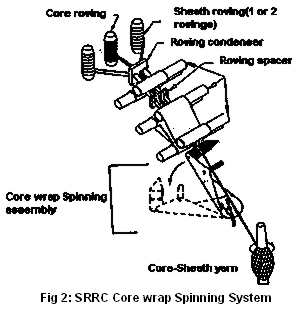
2.3 A.R.S. spinning system
In this system the core may be a filament yarn or a spun yarn shown in figure 3. Two rovings are drafted on both the sides of the core. Shawney reported that the Flame retardant treated ARS core spun cotton yarn made fabrics Provide desire level of fire resistance then the FR treated 100% cotton yarn
In this system the core may be a filament yarn or a spun yarn shown in figure 3. Two rovings are drafted on both the sides of the core. Shawney reported that the Flame retardant treated ARS core spun cotton yarn made fabrics Provide desire level of fire resistance then the FR treated 100% cotton yarn
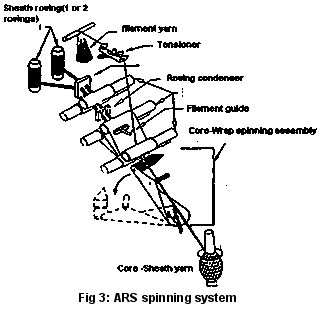
2.4 Core Twin Spun Yarn
Harakawa has developed and patented a Core twin spun yarn system as shown in Fig. 4. The figure is a schematic illusion for the core twin spin yarns. In the spun silk ring spinning frame the drafting part was equipped with an apron device for cotton fibers, because they were shorter then the silk fibers. The continuous filament core-spun yarn passes through a control disc inserted directly behind the front roller in a drafted strand of either cotton or spun silk via a core yarn guide. The drafted spun silk and cotton strands and the scoured silk continuous filament core yarns were twisted together as they emerge from the front rollers.
Usually the core yarn guide remains at a fixed position and also possible to move them by moving the position rollers. When the rollers change the position of the guide, the core yarns migrate periodically from the spun silk to cotton and from cotton to spun silk. When scoured silk core yarn is inserted in the spun silk strand only, this yarn was called �silk �sided� core twin spun yarn; when the core yarn is inserted in the cotton strand only, this yarn is called �cotton-sided� core twin spun yarn; when the core yarn inserted periodically in the both strands, this yarn is called �migrated �core� twin spun yarn.
Harakawa has developed and patented a Core twin spun yarn system as shown in Fig. 4. The figure is a schematic illusion for the core twin spin yarns. In the spun silk ring spinning frame the drafting part was equipped with an apron device for cotton fibers, because they were shorter then the silk fibers. The continuous filament core-spun yarn passes through a control disc inserted directly behind the front roller in a drafted strand of either cotton or spun silk via a core yarn guide. The drafted spun silk and cotton strands and the scoured silk continuous filament core yarns were twisted together as they emerge from the front rollers.
Usually the core yarn guide remains at a fixed position and also possible to move them by moving the position rollers. When the rollers change the position of the guide, the core yarns migrate periodically from the spun silk to cotton and from cotton to spun silk. When scoured silk core yarn is inserted in the spun silk strand only, this yarn was called �silk �sided� core twin spun yarn; when the core yarn is inserted in the cotton strand only, this yarn is called �cotton-sided� core twin spun yarn; when the core yarn inserted periodically in the both strands, this yarn is called �migrated �core� twin spun yarn.
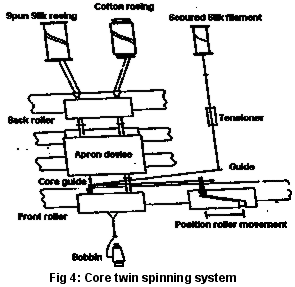
2.5 Composite yarn by Electro static filament charging method
Smith & others [3] developed a method for producing with the mixed construction of staple and filament fibers involved with use of the frictional contact methods by using electro static system and short comings with this system was only hydrophobic fibers can be handled, and often filaments tend to break and wound around the rotating components. This system prone to safety problems because of the high voltage required and a water supply required for imparting the electrical conductivity to the continuous filament yarn.
Another electrostatic filament charging method shown in the figure.5 uses two electrodes to separate the multifilament yarn. The filament charging device is described which is based on the principle of two electrodes system; this was employed to separate a multi filament yarn. The separated filaments were then mixed with the staple fibers of roving at the roller nip on the ring spinning system as illustrated in the figure5. The blended ribbon was subsequently twisted to form a yarn. This is an effective measure for resolving the strip back problem.
Smith & others [3] developed a method for producing with the mixed construction of staple and filament fibers involved with use of the frictional contact methods by using electro static system and short comings with this system was only hydrophobic fibers can be handled, and often filaments tend to break and wound around the rotating components. This system prone to safety problems because of the high voltage required and a water supply required for imparting the electrical conductivity to the continuous filament yarn.
Another electrostatic filament charging method shown in the figure.5 uses two electrodes to separate the multifilament yarn. The filament charging device is described which is based on the principle of two electrodes system; this was employed to separate a multi filament yarn. The separated filaments were then mixed with the staple fibers of roving at the roller nip on the ring spinning system as illustrated in the figure5. The blended ribbon was subsequently twisted to form a yarn. This is an effective measure for resolving the strip back problem.
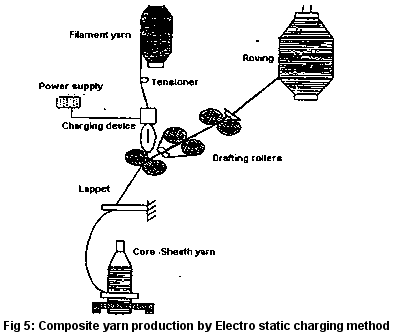
2.5.1 Electro static filament charging
The charging device consists of a pair of hollow cylindrical electrodes shown in the figure 6 made of brass which were fixed in a Perspex cylinder, the top electrode had a inner dia of 1.5mm and the lower electrode with 6mm inner dia was mounted 1.5-2.0mm below the upper one. The tip of the upper electrode is slightly tapered for the purpose of intensifying the electric field strength. The condition of the filament yarn was passed through the narrow passage of the upper electrode to which was connected the positive side of a high voltage supply of at least 4000 Volts. A ceramic guide is attached to the lower electrode to prevent the separated filament from containing the electrode.
The continuous filament yarn is first electrically charged by connecting the top electrode, so that the individual filament s constituting the yarn tend to repel one another because they will carry the same charge sign, furthermore owing to the action of electrostatic filed established between the electrode, there is attention between the filaments and the lower electrodes, reinforcing the tenancy of the filament s to be pulled outward to form a balloon liken shape. To reduce the resistance of the yarn in the path it was applied with anti static agent (Permalose TM).
The charging device consists of a pair of hollow cylindrical electrodes shown in the figure 6 made of brass which were fixed in a Perspex cylinder, the top electrode had a inner dia of 1.5mm and the lower electrode with 6mm inner dia was mounted 1.5-2.0mm below the upper one. The tip of the upper electrode is slightly tapered for the purpose of intensifying the electric field strength. The condition of the filament yarn was passed through the narrow passage of the upper electrode to which was connected the positive side of a high voltage supply of at least 4000 Volts. A ceramic guide is attached to the lower electrode to prevent the separated filament from containing the electrode.
The continuous filament yarn is first electrically charged by connecting the top electrode, so that the individual filament s constituting the yarn tend to repel one another because they will carry the same charge sign, furthermore owing to the action of electrostatic filed established between the electrode, there is attention between the filaments and the lower electrodes, reinforcing the tenancy of the filament s to be pulled outward to form a balloon liken shape. To reduce the resistance of the yarn in the path it was applied with anti static agent (Permalose TM).
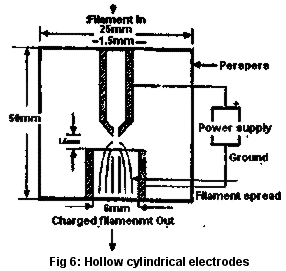
It
was noted that the width of the filament spread over decreased with
increase in the roller speed. At 0.33% antistatic fish on core with
positive top electrode appeared to give largest spreading effect. Incase
of 0.15 %antistatic finishes on the core with negative top electrode
give a better filament spread .C.V% of measurements found to be large
due to migration during the coating or drying out in the processes and
variation in the feed tension.
It was reported that filament spread improved as the potential difference of the applied voltage between the electrodes increased, due to intensified electric field. The yarn produced by this system has sufficient twist to prevent the surface fibers from sliding along the filament core.
It was reported that filament spread improved as the potential difference of the applied voltage between the electrodes increased, due to intensified electric field. The yarn produced by this system has sufficient twist to prevent the surface fibers from sliding along the filament core.
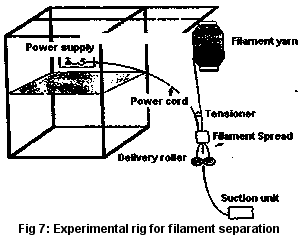

3.0 Effect of Process variables on Ring Core-spun yarn properties
The process variables that affect the core-spun yarn properties are:
The process variables that affect the core-spun yarn properties are:
1. Core sheath ratio
2. Pre tension applied to the core material.
3. Spinning draft
4. Number of roving feed and
5. Twist
3.1 Core- sheath ratio
It has been found that decreasing sheath content will increase the strength of the core-spun yarn. Apart from this there is an improvement in the extension and the evenness properties. In the case of core-spun sewing threads, a 2: 1 ratio of core sheath gives poor core coverage, and may raise problem of stripping off the sheath during the sewing, whereas, with a 1:1 core sheath ratio the striping off problem reported to minimize .
3.2 Pre- tension to Core material
The pre tension is needed to regulate the geometrical position of the filament. This input tension varies with the twist factor, size and the quality of the filaments used. Balasubramaniam furnished a method for optimizing the tension of the core filament in the core spinning process. Colored filament was passed over a tension device of attachment and fed before the nip of the front roller of the ring frame. The pre tension was gradually raised until the colored filament is completely covered by the cotton fibres, and this value was taken as the optimum input tension. It was approximately 10% of the breaking load of the core yarn. An introduction of a compensatory tensioner can be reducing the tension variation . An extension of 1 % to the core filaments while feeding to the ring frame ensures no buckling or curling of sheath fibres. Core yarns are usually pre- tensioned to an extension of around 5-10% for flat continuous filaments yarns, about 30% for textured yarns and up to 400% for an electrometric core. If insufficiently tensioned, the filament will either periodically appear at the yarn surface, grin through or become wrapped around the fibre ribbon as the ribbon being twisted .
3.3 Spinning draft
Spinning drafts can be varied to obtain the required yarn count based on the core the sheath ratio.
3.4 Number of Roving feed
The possible ways of feeding the core material at the front roller nip with respect to roving are:
1. Filament at the center of the rovings
2. Filament at the sides of the roving
3. Filament on the top of the roving.
Two-rove feeding (Filament at the center of the rovings) provides better core positioning and control during spinning influences the structure and properties of core-spun yarns .
3.5 Twist
Adequate cohesion obtained in individual yarns at high twist rates and it is minimize the sheath slippage .In addition to this, the filament pre-twist in opposite direction to the ring twist reduce the sheath slippage . The extension of the core-spun yarn tends to reduce at higher twist levels .
It has been found that decreasing sheath content will increase the strength of the core-spun yarn. Apart from this there is an improvement in the extension and the evenness properties. In the case of core-spun sewing threads, a 2: 1 ratio of core sheath gives poor core coverage, and may raise problem of stripping off the sheath during the sewing, whereas, with a 1:1 core sheath ratio the striping off problem reported to minimize .
3.2 Pre- tension to Core material
The pre tension is needed to regulate the geometrical position of the filament. This input tension varies with the twist factor, size and the quality of the filaments used. Balasubramaniam furnished a method for optimizing the tension of the core filament in the core spinning process. Colored filament was passed over a tension device of attachment and fed before the nip of the front roller of the ring frame. The pre tension was gradually raised until the colored filament is completely covered by the cotton fibres, and this value was taken as the optimum input tension. It was approximately 10% of the breaking load of the core yarn. An introduction of a compensatory tensioner can be reducing the tension variation . An extension of 1 % to the core filaments while feeding to the ring frame ensures no buckling or curling of sheath fibres. Core yarns are usually pre- tensioned to an extension of around 5-10% for flat continuous filaments yarns, about 30% for textured yarns and up to 400% for an electrometric core. If insufficiently tensioned, the filament will either periodically appear at the yarn surface, grin through or become wrapped around the fibre ribbon as the ribbon being twisted .
3.3 Spinning draft
Spinning drafts can be varied to obtain the required yarn count based on the core the sheath ratio.
3.4 Number of Roving feed
The possible ways of feeding the core material at the front roller nip with respect to roving are:
1. Filament at the center of the rovings
2. Filament at the sides of the roving
3. Filament on the top of the roving.
Two-rove feeding (Filament at the center of the rovings) provides better core positioning and control during spinning influences the structure and properties of core-spun yarns .
3.5 Twist
Adequate cohesion obtained in individual yarns at high twist rates and it is minimize the sheath slippage .In addition to this, the filament pre-twist in opposite direction to the ring twist reduce the sheath slippage . The extension of the core-spun yarn tends to reduce at higher twist levels .
4.0 Core-spun yarn production by Rotor spinning system
Nield and Ali have developed a technique in rotor-spinning machine to produce core-spun yarns as shown in Fig. 8. Twist efficiency and pre-tension of filament are the influencing factors in core spinning. In order to increase the contact area between yarn arm and doffing tube (for increasing the twist efficiency), a copper flange was soldered to the inner end of the doffing tube. The doffing tube was mounted on a ball bearing, rotated by a separate drive opposite to the rotation of the rotor with a speed ratio of 1:9. The rotating doffing tube inserts a false twist and pushes twist back to the peel-off point. The rotation of rotor wraps the yarn arm around the continuous filament core. A minimum pre-tension is necessary to avoid filament flung out in to the rotor-collecting surface. The core is not twisted during this process. It is economical to produce coarse core-spun yarns through rotor machine than the ring core-spun yarns.
Nield and Ali have developed a technique in rotor-spinning machine to produce core-spun yarns as shown in Fig. 8. Twist efficiency and pre-tension of filament are the influencing factors in core spinning. In order to increase the contact area between yarn arm and doffing tube (for increasing the twist efficiency), a copper flange was soldered to the inner end of the doffing tube. The doffing tube was mounted on a ball bearing, rotated by a separate drive opposite to the rotation of the rotor with a speed ratio of 1:9. The rotating doffing tube inserts a false twist and pushes twist back to the peel-off point. The rotation of rotor wraps the yarn arm around the continuous filament core. A minimum pre-tension is necessary to avoid filament flung out in to the rotor-collecting surface. The core is not twisted during this process. It is economical to produce coarse core-spun yarns through rotor machine than the ring core-spun yarns.
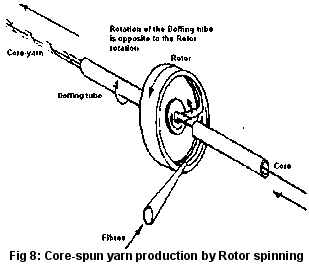
5.0 Core-spun yarn production by Friction spinning system
In friction spinning system the fibres are individually collected and twisted to form yarn. A wide range of staple length can be processed by this system. In Dref II system, the deposition and the twist of fibres on to the yarntail is to be replaced by a filament core to obtain full coverage of core. Dref-III (Wrap spinning system) is a frictional spinning process; a drafted ribbon of parallel fibres that constitute the bulk of the spun yarn is wrapped by either surface fibres protruding from the ribbon or by continuous filaments so as to impart coherence and strength to the resulting yarn
It is believed that the core is false twisted by the rotation of the friction drums before being wrapped by the sheath fibres . Strength of the Dref III core-spun yarns have direct relationship with the strength of core filaments and number of sheath fibres that are active in generating radial pressure due to their structural helical configurations. The effectiveness of wrapping of sheath fibres depends on physical and mechanical characteristics of fibres, configuration, length variations, firmness of the wrap and wrap angle .
6.0 Core-spun yarn production by MJS spinning system
It was reported that the Air-jet spinning could be used for producing core yarns after optimizing process parameters. A relatively higher first nozzle pressure is advantageous for improving sheath-slippage resistance. The use of higher spinning speed and wider condenser markedly improves the tenacity, breaking extension, initial modulus and sheath-slippage resistance and affects the yarn hairiness, mass irregularity and flexural rigidity. However, yarn properties deteriorate at high spinning speed especially for finer yarns . The schematic diagram of MJS spinning system for the production of core- spun yarn is shown in Fig.9
In friction spinning system the fibres are individually collected and twisted to form yarn. A wide range of staple length can be processed by this system. In Dref II system, the deposition and the twist of fibres on to the yarntail is to be replaced by a filament core to obtain full coverage of core. Dref-III (Wrap spinning system) is a frictional spinning process; a drafted ribbon of parallel fibres that constitute the bulk of the spun yarn is wrapped by either surface fibres protruding from the ribbon or by continuous filaments so as to impart coherence and strength to the resulting yarn
It is believed that the core is false twisted by the rotation of the friction drums before being wrapped by the sheath fibres . Strength of the Dref III core-spun yarns have direct relationship with the strength of core filaments and number of sheath fibres that are active in generating radial pressure due to their structural helical configurations. The effectiveness of wrapping of sheath fibres depends on physical and mechanical characteristics of fibres, configuration, length variations, firmness of the wrap and wrap angle .
6.0 Core-spun yarn production by MJS spinning system
It was reported that the Air-jet spinning could be used for producing core yarns after optimizing process parameters. A relatively higher first nozzle pressure is advantageous for improving sheath-slippage resistance. The use of higher spinning speed and wider condenser markedly improves the tenacity, breaking extension, initial modulus and sheath-slippage resistance and affects the yarn hairiness, mass irregularity and flexural rigidity. However, yarn properties deteriorate at high spinning speed especially for finer yarns . The schematic diagram of MJS spinning system for the production of core- spun yarn is shown in Fig.9
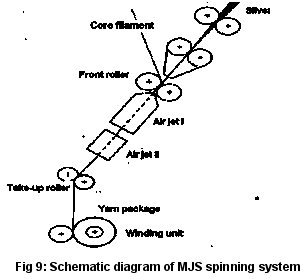

7.0 Core-spun sewing threads
The sewing thread is subjected to heavy stresses and strain at the various points during the processes. The speed of the needle is accelerated to over 180 km/hr in the forwarded direction brought to rest suddenly and again accelerated to backwards before returning to the rest. The whole cycle is repeated approximately 120times per seconds. Incase of lock stitch the seam sewn at 12stitches per inches each length of thread is passed through the needle up to 40 times before being set in to the fabric. Depends on fabric thickness, the sewing machine needle reaches temperature of about 360 C at 4000 s.p.m., the temperature of the needle during the operation depends on the number of piles of fabric to be sewn and the frictional forces between the needle to fabric and needle to thread. 100%Cotton threads has difficult to accompany the sewing machine with high speed rate, similarly 100%Synthetic threads has limitations due to high needle temperature. Hence the Core-spun sewing threads can meet the high speed.
The sewing thread is subjected to heavy stresses and strain at the various points during the processes. The speed of the needle is accelerated to over 180 km/hr in the forwarded direction brought to rest suddenly and again accelerated to backwards before returning to the rest. The whole cycle is repeated approximately 120times per seconds. Incase of lock stitch the seam sewn at 12stitches per inches each length of thread is passed through the needle up to 40 times before being set in to the fabric. Depends on fabric thickness, the sewing machine needle reaches temperature of about 360 C at 4000 s.p.m., the temperature of the needle during the operation depends on the number of piles of fabric to be sewn and the frictional forces between the needle to fabric and needle to thread. 100%Cotton threads has difficult to accompany the sewing machine with high speed rate, similarly 100%Synthetic threads has limitations due to high needle temperature. Hence the Core-spun sewing threads can meet the high speed.

7.1.1 Doubling
Two or three ends are twisted together to make sewing thread. This twisting process improves the cotton covering of the core-spun yarn. Disadvantages of the single core yarn are that the outer cover of staple fibers may rather be easily removed from the core filament by abrasion, this is not recommended for sewing thread, since thread ism severally abraded against the needle during the sewing. It requires higher resistance to abrasion. The doubling together of two or more single core-spun yarn effectively overcomes this problem by binding with the structure fibers more firmly with the structure.
7.1.2 Heat setting
Fibres and filaments used for the spinning core yarns having different characteristics and the resultant yarn may shrink differently, so to achieve balance and set of these yarns, heat setting has to be done. Setting of twist is done by steaming the yarn in an auto calve with steam pressure of 0.6 kg/cm2 for 30-60 minute. Temperature of the steam has to be maintained with 100-105X C. The steaming time is decided on the basis of twist level in the doubled yarn. The heat-setting leads to stabilization and equalization of the elongation properties of the thread and it prevent the snarling. Polyester and Nylon threads required high pressure steaming and the industrial sewing threads needed low pressure steaming.
7.1.3 Hot stretching
Hot stretching is a process of heating the thread to pre determined and controlled temperature in the range of 180-240 Centigrade with tension and length control. Heat setting operation causes a decrease in the modulus and increase in the extensibility of the thread. Consequently when high modulus thread requires subsequent stretches. This hot stretching improves the thermal stability and reduces the extensibility. The sewing thread length improved 4. -6%. The specific tenacity improved to 3-5%. This helps to get improvement in dyeing and kink free sewing thread.
7.1.4 Wet processing
After heat setting threads has to be converted in to hank form for required wet processing treatments. High color fastness and precise shade matching are the key factor requirements for Core-spun sewing threads. Normally to get uniformity, cross wound packages with high pressure equipments used.
7.1.5 Lubrication
Gliding and cooling effect on the needle could be done with effective lubricants. Good lubricant must not clogs on the needle eye or causes stain. The lubricant must allow the thread to unwind evenly from the package. The friction between the abrading surface should be minimized with lubrications inexpensive lubricants will be preferred.
7.1.6 Final Winding
The core spun sewing threads after the treatments, to be wound on a suitable package like spool, cop or king spool with required length .
Two or three ends are twisted together to make sewing thread. This twisting process improves the cotton covering of the core-spun yarn. Disadvantages of the single core yarn are that the outer cover of staple fibers may rather be easily removed from the core filament by abrasion, this is not recommended for sewing thread, since thread ism severally abraded against the needle during the sewing. It requires higher resistance to abrasion. The doubling together of two or more single core-spun yarn effectively overcomes this problem by binding with the structure fibers more firmly with the structure.
7.1.2 Heat setting
Fibres and filaments used for the spinning core yarns having different characteristics and the resultant yarn may shrink differently, so to achieve balance and set of these yarns, heat setting has to be done. Setting of twist is done by steaming the yarn in an auto calve with steam pressure of 0.6 kg/cm2 for 30-60 minute. Temperature of the steam has to be maintained with 100-105X C. The steaming time is decided on the basis of twist level in the doubled yarn. The heat-setting leads to stabilization and equalization of the elongation properties of the thread and it prevent the snarling. Polyester and Nylon threads required high pressure steaming and the industrial sewing threads needed low pressure steaming.
7.1.3 Hot stretching
Hot stretching is a process of heating the thread to pre determined and controlled temperature in the range of 180-240 Centigrade with tension and length control. Heat setting operation causes a decrease in the modulus and increase in the extensibility of the thread. Consequently when high modulus thread requires subsequent stretches. This hot stretching improves the thermal stability and reduces the extensibility. The sewing thread length improved 4. -6%. The specific tenacity improved to 3-5%. This helps to get improvement in dyeing and kink free sewing thread.
7.1.4 Wet processing
After heat setting threads has to be converted in to hank form for required wet processing treatments. High color fastness and precise shade matching are the key factor requirements for Core-spun sewing threads. Normally to get uniformity, cross wound packages with high pressure equipments used.
7.1.5 Lubrication
Gliding and cooling effect on the needle could be done with effective lubricants. Good lubricant must not clogs on the needle eye or causes stain. The lubricant must allow the thread to unwind evenly from the package. The friction between the abrading surface should be minimized with lubrications inexpensive lubricants will be preferred.
7.1.6 Final Winding
The core spun sewing threads after the treatments, to be wound on a suitable package like spool, cop or king spool with required length .
8.0 Advantages of Core-spun yarns
Development of core-spun yarn with ring spinning system unveils path for new products including high performance textiles, sewing threads and in the garmenting areas due to its exceptional strength, outstanding abrasion resistance, consistence performance sewing machine, elasticity for the stretch requirements, excellent resistance in perspiration, ideal wash and wear performance and permanent press.
Development of core-spun yarn with ring spinning system unveils path for new products including high performance textiles, sewing threads and in the garmenting areas due to its exceptional strength, outstanding abrasion resistance, consistence performance sewing machine, elasticity for the stretch requirements, excellent resistance in perspiration, ideal wash and wear performance and permanent press.
PRECAUTIONS NEEDED TO SPUN CORE YARNS
1. Selection of superior core spun yarn attachment is more important.
2. Uniform & high quality roving should be used for core spun yarn process.
3. Accurate adjustments of rings and travellers to make better package of cop without forming steps.
4. Good lighting by increasing illumination to 120 LUX is necessary for easy detection of filament breakage.
5. Excellent cleaning devices to prevent fly deposits.
6. Conditions of cots, aprons and drafting rollers should be strictly maintained.
7. Accurate centering of revolving guides will avoid friction, creating micro breaks.
8. Well trained and motivated operators should be engaged for perfect handling of filament package and yarn piecing, gaiting in spinning.
9. Careful handling & storing of filament material is very important to prevent damages
10. Department temperature and humidity should be strictly maintained at the optimum level.
11. Perfect alignment with roving, higher level of twist, heavier weight travellers are required to avoid core exposure.
12. Proper yarn number calculation and core content determining method should be properly adopted
2. Uniform & high quality roving should be used for core spun yarn process.
3. Accurate adjustments of rings and travellers to make better package of cop without forming steps.
4. Good lighting by increasing illumination to 120 LUX is necessary for easy detection of filament breakage.
5. Excellent cleaning devices to prevent fly deposits.
6. Conditions of cots, aprons and drafting rollers should be strictly maintained.
7. Accurate centering of revolving guides will avoid friction, creating micro breaks.
8. Well trained and motivated operators should be engaged for perfect handling of filament package and yarn piecing, gaiting in spinning.
9. Careful handling & storing of filament material is very important to prevent damages
10. Department temperature and humidity should be strictly maintained at the optimum level.
11. Perfect alignment with roving, higher level of twist, heavier weight travellers are required to avoid core exposure.
12. Proper yarn number calculation and core content determining method should be properly adopted
13.
While producing core yarn polyester / Cotton yarn will be drafted and
filament should be processed through front Roller region.
14.For good blended, we should provide guide in between cradle and front top roller.
15.Proper piecing method should be implemented in spinning to avoid improper core yarn.
16.Traverse motion should not be utilised for producing good core yarn.
17.Precaution should to be taken for keeping the drafting zone clean. Cots, apron condition, should be fluff and fly free.
18.Buffing should be done for every 30 days for producing Good yarn.
19.Traveller should be changed once in week. Special creel attachment should to be provided for creeling Filament yarn.
14.For good blended, we should provide guide in between cradle and front top roller.
15.Proper piecing method should be implemented in spinning to avoid improper core yarn.
16.Traverse motion should not be utilised for producing good core yarn.
17.Precaution should to be taken for keeping the drafting zone clean. Cots, apron condition, should be fluff and fly free.
18.Buffing should be done for every 30 days for producing Good yarn.
19.Traveller should be changed once in week. Special creel attachment should to be provided for creeling Filament yarn.
20.Optimum unwinding tension of core filament is to be ensured for quality core yarns
21.Another major factor influencing the quality is the selection of
traveller. It is essential that round cross section travellers are
selected in order to ascertain that the cover is not disturbed (peeling
off).
22.Yarn balloon is to be closely monitored to ensure that it does not touch
any parts like separators, empties and gets disturbed.
23.Spindle speeds
must be reduced to an extent that breakages are maintained well below 1 / 100 spindle hour.
Special Training to workers highlighting probable
reasons detrimental to quality is a must.
24. Core filament should not be missing at any place in the yarn to provide necessary stop motions for the same
25. Yarn splice quality should be good.
25. Yarn splice quality should be good.
26. Cops should be taken out from ends down spindles and keep the cops separately
and remove the yarn till the core yarn comes to spring action, which is the
indication for Lycra content.
and remove the yarn till the core yarn comes to spring action, which is the
indication for Lycra content.
27.Set CA, CCA Setting in Autoconer as 6% to ensure Lycra missing
28. Piecing hands and fingers should be free from dirt and oil
No comments:
Post a Comment